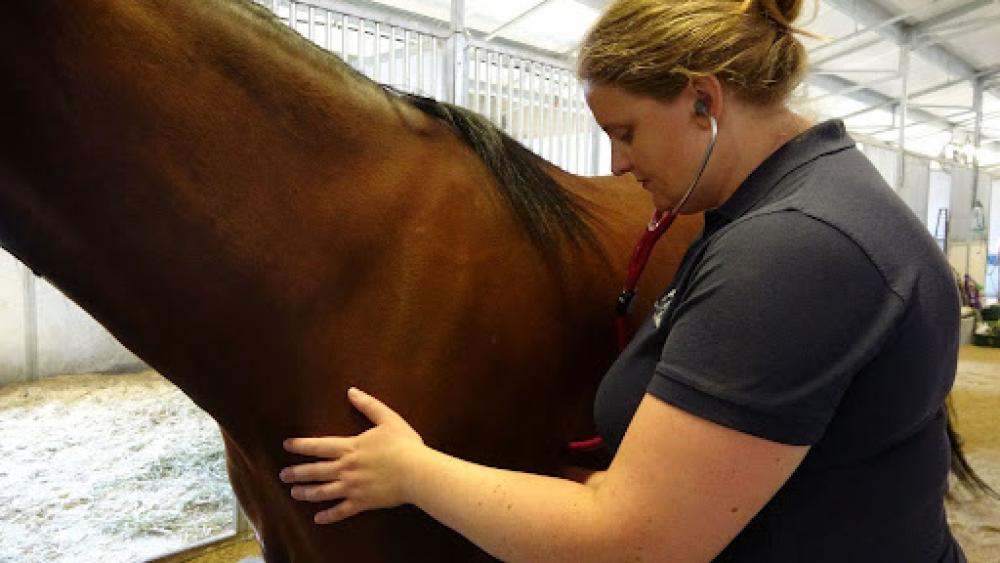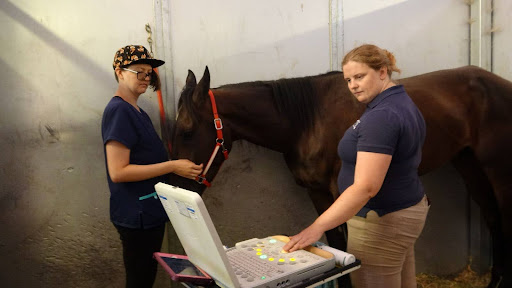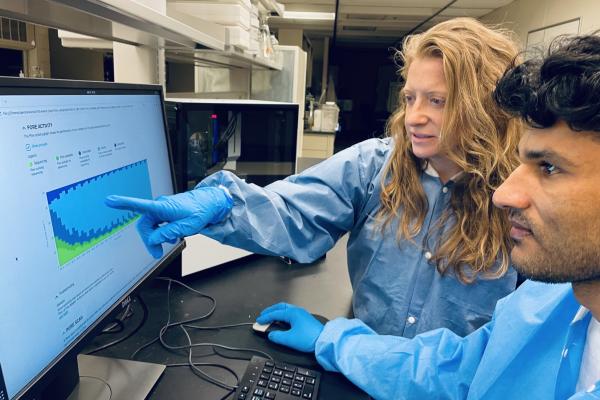Heart of the matter: Sian Durwar-Akhurst wants to solve the mystery of sudden cardiac death in racehorses
November 21, 2023

Photo courtesy of Kendall Blanchard.
When Dr. Sian Durward-Akhurst heard about the death of Practical Move, the thoroughbred racehorse who was a contender at this year’s Breeder’s Cup, she was crushed. Beyond the tragedy of his individual death, what makes it so crushing is that though unexpected, it wasn’t unusual. About 1.3 horses die for every thousand race starts, roughly 400 racehorses per year. Many of those deaths remain a mystery—and it’s that mystery that drives Durward-Akhurst’s research.
Growing up in Hertfordshire, England, Durward-Akhurst always wanted to be a veterinarian, and she planned on working in mixed practice in her hometown. But during veterinary school at the University of Glasgow and an internship at the Royal Veterinary College, she developed a passion for equine cardiology that led her to the U.S., where she saw the greatest opportunity to gain clinical experience.
She arrived at the University of Minnesota in July 2012 to complete her residency and Master’s degree, during which she investigated the genetic basis of a highly debilitating muscle disease in Quarter Horses. Her work led to the development of a genetic test for the disease, which is now called myosin heavy chain myopathy . “A genetic test is non-invasive and relatively affordable, and this test allows owners to understand their horse's risk of developing MYHM and to implement preventative measures,” she describes. “This research really highlighted the importance of genetics for me, and that is why I decided to stay on to do a PhD in comparative genetics.” She was excited for the opportunity to join the faculty as an Assistant Professor in the Department of Veterinary Clinical Sciences in 2021.

One of primary issues she examines through the lens of genetics is sudden cardiac death (SCD). SCD is responsible for about 20% of racehorse deaths, though about half never receive a formal diagnosis. SCD can stem from a number of problems, such as a ruptured vessel or a structural problem with the heart, which can be detected after death.
But the most challenging cases are thought to stem from an arrhythmia, or an irregular heartbeat.
“It sounds a bit like balls in a tumble dryer,” Durward-Akhurst describes. “When the electrical activity of the heart happens, it needs to be in a very precise order. With arrhythmias, that gets disrupted—so the signal is bouncing around but not doing the circuit it’s supposed to do regularly.”
This means that blood isn’t pumped as it should be—or sometimes at all.
But because many arrhythmias aren’t caused by any structural problems in the heart, there’s no way to predict when or if a horse might be affected. “When you listen to or image these hearts, they’re normal. Many have normal ECGs until they go into a fatal arrhythmia,” Durwrd-Akhurst says. Like Practical Move, “most of these horses are completely fine until they're not fine.”
Her vision, however, is that a combination of genetic testing and ECGs will enable diagnosis of potentially fatal arrhythmia before it becomes a problem.
The first step is to find common genetic markers among horses who died of SCD. In order to do this, she collaborates with racetracks around the country who have agreed to send hair samples when a death occurs, which she uses to conduct whole genome sequencing. So far, she’s received and sequenced 60 samples,—including from Medina Spirit, the winner of the 2021 Kentucky Derby who died shortly after of SCD. Her goal is to eventually reach 200. The more samples she receives, the more specifically she can hone in on the variants that likely put a horse at risk.
Finding markers that determine a horse’s level of risk would help to develop a plan for how frequently a horse should be monitored, and other precautions that should be taken. This would make sudden cardiac death predictable–and thus preventable.
Durward-Akhurst’s work has significant implications for humans as well. “I’m super passionate about horses and improving health and our ability to determine which ones will have problems,” she says. ”But there’s also a translational aspect—racehorses are actually a great model for human disease."
Studying SCD in humans is difficult because it is fortunately relatively uncommon, and because humans have much greater genetic diversity than horses, which makes it harder to find genetic variants that are likely related. But “when we look at horses,” Durward-Akhurst describes, “they have much less genetic diversity, so there’s less ‘background noise’ to sort through.” And their heart function is more similar to humans than that of other smaller animals. Given these factors, she says, “One of my big pushes now is to get funding to look at similarities in genetics between humans and horses in SCD and atrial fibrillation,” which is one specific type of arrhythmia that her research also explores.
Durward-Akhurst credits the strength of the research programs at the College and University for preparing her to tackle big problems, and giving her the resources to make progress. Her transdisciplinary collaborations with colleagues in the Medical School and College of Science and Engineering, as well as the support she has received from the Clinical and Translational Science Institute, she says, have strengthened her ability to explore the questions she’s passionate about. “I’m also lucky to be part of the Equine Genetics and Genomics Lab here at CVM, which is one of the biggest equine genetics labs in the world. The strength of the genetics training I received there as a student really prepared me well,” she says.
Find out more about the Akhurst lab here.


